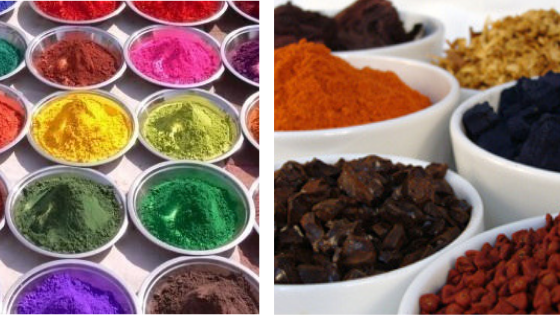As more people are awakening to the harmful effects of dyes and synthetics in personal care products, the need to understand the word "natural" is more important than ever. Specifically, I want to address the word natural being associated with neon colored bath bombs, soaps, make ups, etc.
When I first started creating bath products, I spent countless hours researching the various ways to add color, and it was so overwhelming I decided to stay away from it completely. I didn't want to ruin the purity of the product, obviously, and my main goal was to make sure that every ingredient has a tangible benefit to the bather's body.
One of the things I learned through my research: there's no such thing as "natural" when it comes to most cosmetic dyes, even the ones being sold as "natural".
Natural Vs Synthetic Ingredients
In short, natural means of the Earth. A plant or mineral straight from the source, pure and untampered with. That means that anything that is chemically treated or manmade is by default, synthetic.
Not every plant is safe or helpful to humans, and not everything synthetic is toxic. But is important to label things objectively.
As you may recall from our post The Truth About "Safe Synthetics" there is very little regulation in the cosmetics industry when it comes to labeling and ingredient testing. There is nothing stopping companies from putting the words "natural"and "fresh"on the front of a package, and outright listing synthetic ingredients on the back.
For example- if you look at the leading "natural" bath bomb ingredient label, there’s about 25 different items listed. There's a few natural ingredients like cocoa butter and oils, and then you'll find things like Synthetic Fluorphlogopite (aka dyed Mica), Laureth 4, Propylene Glycol, and potential toxic food dyes such as Red 28, Blue 1, and Yellow 5 - these can also be disguised as "batch certified colorants".
It's up to us as consumers to be diligent about what we choose to put on our bodies, and I feel it is my duty to share research and start a conversation about it.
In this post, we're diving into the world of natural vs synthetic coloring in bath products. Specifically, the ingredient Mica and how it is being mislabeled as natural.
What is Mica?
Mica is a silicate mineral found in granite, crystals, and other rocks. It is naturally occurring and when found in its natural form, it is a range of earth colors mostly off-white, silver or gold(ish) in color. The composition of Mica allows it to be ground down into a fine powder-like dust, making it versatile and mutable. Mica has many uses including extending and brightening the pigmentation of car paint, thermal insulation in the electrical industry, filler in plastics, rubber and cement, and adding a shimmery effect to cosmetics and beauty products.
So... what’s the problem? Why are we talking about it and why are we adamant about never using Mica in our products?
Is Mica Safe For Skin?
Almost every single brightly colored bath bomb on the market that advertises being natural has Mica listed as the colorant. I wanted to know exactly what it was before I blindly put it in a bath product. I learned right away that there are two types of Mica, naturally mined Mica vs synthetically made Mica.
In both cases, I found that the main health concern for Mica exposure is pneumoconiosis, or disease of the lungs caused by inhalation of dust, and characterized by coughing, inflammation, and fibrosis. The most at risk for this are of course the miners onsite digging the mineral out of the depths of the earth, and the laborers on the factory line dropping Mica into mass produced products for 8 hours a day. Since Mica is ground into a nanoparticle, its composition allows it to penetrate through layers of skin and even seep into the lungs.
Currently, the FDA does not have legal means to require testing for the amount of Mica we can “safely” be in contact with. So when it comes to answering the question “is Mica safe for skin?” I believe the answer is - we don’t know.
It is important to remember that just because something is natural, does not necessarily mean it is safe. Plenty of toxins are “natural” and we would never dream of putting them on our skin.
The Problems With Natural Mica
When using a natural mineral like Mica, one big concern is the presence of other minerals like lead, arsenic & mercury. These can be very dangerous and many companies opt for synthetic Mica to avoid the presence of unwanted minerals.
Upon further investigation into the craze of Mica in our self care products, I was horrified to learn of the reality of the natural Mica mining industry. By far, the largest deposits of Mica in the world are in India, and specifically in the remote, impoverished states of Jharkand and Bihar in the northeastern part of the country. This region has been dubbed the “Mica belt”, and accounts for roughly 25 percent of all Mica sourced in the world.
Unfortunately, the Mica mining industry in these areas are supported by illegal child labor and the working conditions are dangerous and even fatal. Children as young as 5 are put to work deep into the crevices of the earth, hammering at unstable rock and exposing themselves to poisonous scorpions and snakes. In 2016, the death of seven children in two months caused investigation into the supply chain of Mica in the “Mica belt”. For the past 2 years, efforts have been made to legalize Mica mines to improve and regulate working conditions and mitigate child labor concerns. Enforcement of regulations are slow moving at best, and with the number of children born undocumented in northeastern India every year, we will likely never have an accurate account of what the Mica mining supply chain looks like there.
 What is Synthetic Mica?
What is Synthetic Mica?
In order to avoid other dangerous trace minerals & in response to the children and communities being exploited so we can achieve a nice even shimmer, many cosmetic and personal care companies have started using Fluorphlogopite, or synthetic fluorine substituted Mica. Synthetic Mica is composed of magnesium aluminium silicate sheets (which weighs down the mineral in its natural form); then weakly bound together by potassium and produced at extremely high temperatures (1100°).
How Is Mica Colored?
For both natural & synthetic Mica, we still have not discussed how it is being colored. This may be the most shocking part of all of my research. What if I told you that the same dyes you have been trying to avoid (Yellow 10, Blue 1, Red 28 etc.) are the exact same dyes in the bath bombs you've been soaking in, but you thought it was natural Mica? Unfortunately, this is most likely the case.
Mica is dyed to produce bright, sought after colors. As we mentioned before, its natural color ranges in earthy shades of silver, gold, even gray, brown, green, rose, and white. To produce all of the colors you see on the market, Mica is dyed with either Ultramarines, Iron Oxides or Dyes. Therefore, there are no colored Micas on the market that are 100% natural.
1. Ultramarines boast beautiful deep blue colors, originally made by grinding Lapis Lazuli. These types of dyes can NEVER be used in bath bombs, or any other product containing citric acid, as it will create a reaction producing horrid smelling sulfur.
2. Iron Oxides may be deemed safe for cosmetic use, but they are only safe for external use. Many are not safe for lips or eyes. Because the nature of a bath bomb & soaking your entire body in it, these are generally deemed not safe for use in bath bombs by the FDA.
3. FD&C Dyes aka Food coloring... usually called Yellow 10, Blue 1, Red 40, etc. These dyes are derived from petroleum, like crude oil or coal, and are banned in many countries due to their potential link to cancer and contamination with toxic substances. There is a lot of concern around these dyes, but the one thing we can agree on, many are interfering with childhood development & linked to hyperactivity. And many can agree more research needs to be done.
Information on FDA regulations and dyes can be found here and here. You may see why I was so confused to start. The research on the safety of synthetic dyes is controversial at best, with no hard evidence either direction. I haven't even mentioned the fact that when these dyes are used another chemical ingredient needs to be added - Polysorbate. The biggest concerns with polysorbates are the potential presence of carcinogens including ethylene oxide and 1,4 dioxane.
So here's my take on it:
These dyes are created and used with the sole intention of adding vibrant color. They offer no benefit, and even after decades of testing we still have no idea just how bad they are for human consumption. You are also putting all of the trust in the company producing the product to research and know all of regulations for the colors they use, and as we mentioned before, there is little to no accountability in enforcing these regulations. Lastly, when it comes to testing if these colors are safe, all of that testing is on animals. Just because the final product you buy wasn't tested on animals doesn't mean that each ingredient wasn't.
What Colors Are Safe?
Simply put, I believe plants are the best, natural way to color food and cosmetics. Nature provides in abundance all that we need to thrive, and it's a beautifully colorful place if we are willing to spend the time and energy to source our life from it.

The brilliant blue in our Blue Moon Ball & Dust is derived from organic Spirulina, a cyanobacteria filled with phytonutrients & carotenoids, which is said to help fight free radicals & help repair skin by increasing the creation of new skin cells.
The green hue in our High Moon Ball is from organic Matcha tea, which offers an uplifting and energizing effect to balance the cannabis essential oil. It is made by grinding the entire tea leaf & is filled with antioxidants like epigallocatechin gallate (EGCG), which is helpful in reducing inflammation and improves skin elasticity.
Less is more when it comes to anything you're putting on your body. Every ingredient should serve a clear health purpose. It may seem confusing with so many products & ingredients being marketed as natural. Begin where you are, examine what you are using without judgment and start to make better, more informed choices for your own body.
 Skip to content
Skip to content


1 comment
Thank you for your thorough research.